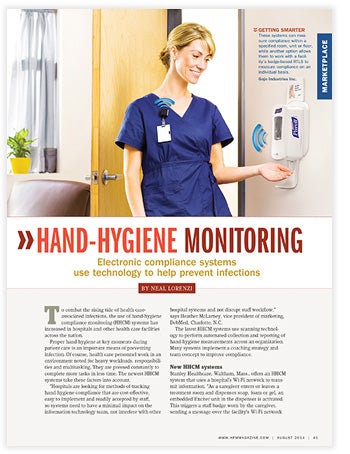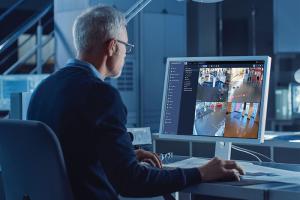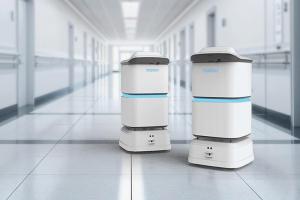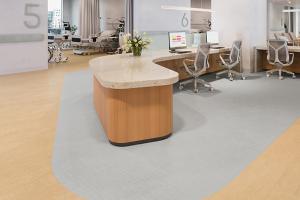Hand hygiene monitoring
 To combat the rising tide of health care-associated infections, the use of hand-hygiene compliance monitoring (HHCM) systems has increased in hospitals and other health care facilities across the nation.
To combat the rising tide of health care-associated infections, the use of hand-hygiene compliance monitoring (HHCM) systems has increased in hospitals and other health care facilities across the nation.
Proper hand hygiene at key moments during patient care is an important means of preventing infection. Of course, health care personnel work in an environment noted for heavy workloads, responsibilities and multitasking. They are pressed constantly to complete more tasks in less time. The newest HHCM systems take these factors into account.
"Hospitals are looking for methods of tracking hand-hygiene compliance that are cost-effective, easy to implement and readily accepted by staff, so systems need to have a minimal impact on the information technology team, not interfere with other hospital systems and not disrupt staff workflow," says Heather McLarney, vice president of marketing, DebMed, Charlotte, N.C.
The latest HHCM systems use scanning technology to perform automated collection and reporting of hand-hygiene measurements across an organization. Many systems implement a coaching strategy and team concept to improve compliance.
New HHCM systems
Stanley Healthcare, Waltham, Mass., offers an HHCM system that uses a hospital's Wi-Fi network to transmit information. "As a caregiver enters or leaves a treatment room and dispenses soap, foam or gel, an embedded Exciter unit in the dispenser is activated. This triggers a staff badge worn by the caregiver, sending a message over the facility's Wi-Fi network that identifies the caregiver, the activation of the dispenser, and the time and location of the wash event, according to Joel Cook, solutions director.
HyGreen Inc., Gainesville, Fla., provides just-in-time coaching to health care workers when they forget to wash, and records the information in real time, says Elena Fraser, vice president of sales and marketing. "The instant the health care worker dispenses the hand wash, both the light-emitting diode on the top of the HHCM sensor and the badge turn green. At the same time, a wireless signal documents the worker identification, time and location and sends that information to the database," she explains.
When the health care worker steps into a zone that is created by a monitor over the patient bed, the monitor recognizes that the badge is green. Again, time, location and worker ID are transmitted to the database. If the health care worker forgets to wash his or her hands, the bed monitor will cause the badge to vibrate, which serves as a subtle reminder.
The SafeHaven hand-hygiene monitoring solution from Georgia-Pacific Professional, Atlanta, uses a real-time locating system (RTLS) that acts like an indoor global positioning system, displaying the locations of specific employees. It incorporates three key components: badges worn by health care workers, which emit infrared (IR) and radio-frequency identification (RFID) signals; sensors in patient rooms and throughout the hospital that read both IR and RFID signals; and dispensers that read badges.
"The granularity of the data makes the system actionable," says Bob Garvin, vice president of sales for health care technology solutions. "Reports reveal information as specific as what was used on the hands, as well as when and where an individual performed or missed hand-hygiene opportunities. Managers can compare results of individuals, different shifts, units or even hospitals."
The DebMed Group Monitoring System tracks whether or not health care workers are washing their hands as frequently as they should be, according to World Health Organization and Centers for Disease Control and Prevention guidelines, says McLarney. "Dispensers utilize proprietary electronics to capture hand-cleaning activity on a group basis, as opposed to requiring employees to wear a badge and be tracked individually. It draws on an evidence-based, statistically valid algorithm that determines how many times workers should have cleaned their hands, based on hospital-specific data such as number of patients in the unit and nurse-to-staff patient ratio, to derive a compliance rate," she explains.
Proventix Systems Inc., Birmingham, Ala., has developed the nGage compliance monitoring system, which allows health care workers to receive user-identified content through an interactive display. These communication units are installed in each patient room and common area, close to the soap or alcohol dispenser. As a worker wearing an RFID badge enters a room, the communication unit detects the presence of the RFID tag through a secure wireless network and the system records whether or not the tagged worker cleansed his hands, according to Harvey Nix, CEO.
"nGage not only measures the number of times a specific wearer of the tag cleanses, but knows how many opportunities there were to cleanse. These data are used for analysis, stratification and presentation within the Web-based and secure nGage application," Nix explains.
Gojo Industries Inc., Akron, Ohio, collaborates individually with each hospital to find an HHCM solution that works, says David Mackay, vice president, sales and marketing, health care. These options include the Smartlink activity monitoring system; Smartlink and RTLS technology; Smartlink clinician-based support; and Smartwatch, which allows users to upload, visualize and analyze data from iScrub, a free application for Apple devices.
Doctors, nurses and other hospital employees deal with pressure situations, which pose a challenge to hand-washing performance and compliance. How do HHCM systems overcome this hurdle?
Stanley Healthcare has developed a solution that is designed to operate seamlessly — with no disruption to staff workflow — to provide the greatest potential for consistent compliance, according to Cook. "There is no need to pause in front of a dispenser, use the dispenser more slowly or place cleaned hands under a 'sniffer.' The health care worker simply uses a dispenser in a normal way and continues about his routine," he notes.
Because hand hygiene typically is performed while workers are on the move, Biovigil Hygiene Technologies LLC, Ann Arbor, Mich., has developed an HHCM system that is designed to support on-the-fly sensing. "The average user performs 100 to 140 hand-hygiene events per shift and they cannot sit still while performing these events. Sink/soap events require a specified time requirement to be met for a worker to receive compliance credit with our system," says Brent D. Nibarger, chief client officer.
Team players
The facilitywide information capturing and reporting aspects of the latest HHCM systems have a "big brother is watching" aspect to them. However, the latest systems implement a staff coaching strategy, rather than being used as a punitive tool.
"Smartlink provides information that helps the infection preventionist to spot trends, learn, educate and coach health care workers on proper hand-hygiene compliance," says Mackay of Gojo. "Not only does this help to identify strong role models for performance improvement, it also helps to share the best practices and tools to help reinforce good hand-hygiene practices."
DebMed's Group Monitoring System measures at the unit level, so it is not punitive. "Many hand-hygiene improvement studies show that providing feedback at the group level encourages a more team-driven approach to improving compliance, which results in better and longer-sustained outcomes," says McLarney.
One key to achieving staff buy-in is a vendor training program. These programs range from brief tutorials to culture change initiatives.
Training by Georgia-Pacific Professional entails instruction for a superuser group and then general training for staff. "SafeHaven uses clinicians to conduct training because they understand work demands and flows as well as hospital culture. We also provide follow-up training and tools because hand hygiene is a journey that requires continual and consistent education and reinforcement," Garvin says.
Proventix provides application training that is a combination of live on-site, live Web-based and self-study tutorials. Initial training typically is presented in person by Proventix representatives at the client facility. Follow-up training primarily is composed of live Web-based and self-study tutorials.
Using the data
Challenges are inherent in electronic monitoring because hand-hygiene tasks are performed quickly and systems must accurately locate where individuals are and who is performing hand hygiene, experts agree.
"To provide a compliance number, not only do the number of hand-hygiene events need to be accurately counted, the number of opportunities must be determined correctly. Various methods are used to determine this 'opportunity' portion. Hospital facilities professionals need to investigate the various HHCM systems to evaluate the validity of these calculations and whether they truly report useful information," says Kim Lees, marketing director, Ecolab Healthcare, Saint Paul, Minn., whose Nexa hand-hygiene dispensing platform is designed to work with a number of HHCM systems.
In general, the information captured by these systems is shared with hospital management and the goal is to use the data to improve performance. "Continuous improvement is a key component of Biovigil's HHCM system," says Nibarger. "Infection prevention personnel can utilize the system to measure specific hygiene events, and analyze them in comparison to audio and visual events.
"For example, when a health care worker enters a patient room, the HHCM system can tell IP personnel how quickly the worker sanitizes his hands. Or IP personnel can increase the volume of an audio alert and/or set off the alert sooner upon room entry. After making adjustments, a measure of the resulting data can be examined to see if the department average increases with a higher-volume, quicker alert."
SafeHaven is an instrument for accountability, and that means different things to different health care organizations, according to Garvin of Georgia-Pacific Professional. "Every hospital has a different culture. Our system is customizable. We provide information and what each hospital does with it is a personal decision," he adds.
Neal Lorenzi is a freelance writer based in Mundelein, Ill.
For more information
For further details on the hand-hygiene systems featured in this month's Marketplace, contact the following vendors:
» Biovigil Hygiene Technologies LLC
www.biovigilsystems.com
» DebMed
www.debmed.com
» Ecolab Healthcare
www.ecolab.com/healthcare
» Georgia-Pacific Professional
www.gppro.com
» Gojo Industries Inc.
www.gojo.com
» HyGreen Inc.
www.hygreen.com
» Proventix Systems Inc.
www.proventix.com
» Stanley Healthcare
www.stanleyhealthcare.com




